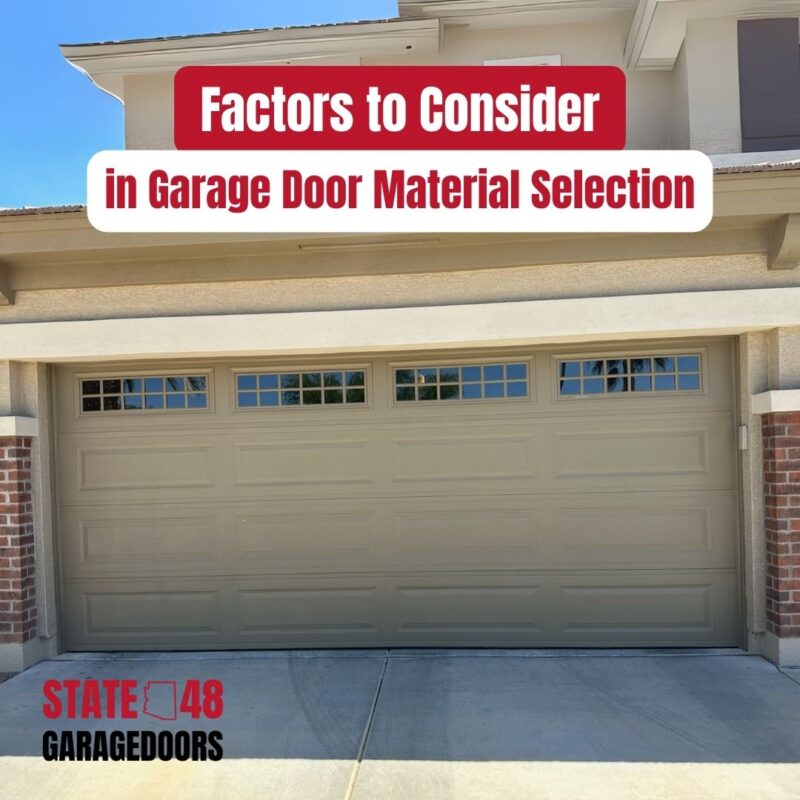
Choosing Between Steel, Wood, or Aluminum Garage Doors
Ever faced the challenge of picking the right garagedoor for your home? I’ve been there, unsure of whether to choose steel, wood, or aluminum garage doors. In this post, I break down the essential factors including durability, maintenance needs, and energyefficiency. You’ll learn how each material stacks up in saving you time and money, and how to match your choice to your property’s style. Let’s sort out your garagedoor problem once and for all.
Understanding the Core GarageDoor Materials

I examine the appeal of steel, with its strong strut support, the natural charm of wood—especially popular in California—and the durable build of aluminum with its powder-coated finish. I also share practical insights on material differences to help you choose the best garage door for your needs.
What Defines a Steel Garage Door?
Steel garage doors stand out for their strength and resistance to humidity changes. I often pair them with a reliable garage door opener that uses a secure button system. For added style, I sometimes include fiberglass accents or glass panels without sacrificing durability.
Characteristics of Natural Wood Garage Doors
Natural wood garage doors offer a warm, classic look that many homeowners love. When combined with a quality insulator, they help reduce air infiltration and boost energy efficiency. These doors often use a steel frame for extra strength. In my experience, they’re also known for reliable performance and solid warranty support.
The Makeup of Aluminum Garage Doors
Aluminum garage doors are a great fit for modern architecture. They offer a lightweight yet sturdy design that resists mold and termite damage. I usually clean them with a gentle soap solution to protect their sleek finish, which often features subtle walnut tones. In my experience, these doors combine practical benefits with a stylish appearance that suits everyday use.
Key Differences in Garage Door Material Composition
Garage door materials vary in how they handle daily wear and weather exposure. Steel doors with powder coating are highly resistant to scratches and rust. Aluminum models retain a clean look and sometimes feature subtle maple tones. Wood doors can include tempered glass accents for a modern style. I often select polyurethane-insulated options to improve energy efficiency. Working with all three types has helped me understand their strengths, making it easier to recommend the right fit for your home.
Comparing Durability and Maintenance Needs

I compare steel‘s fixed performance in weather and impacts, wood‘s upkeep over time, and aluminum’s resistance to corrosion and denting. My insights on design, construction, and even carriage house styles offer clarity on garage door repairs, maintenance, and lifespan expectations. I share my experiences to aid your decision-making on these options, backed by real-life examples including trends on Facebook.
Steel Door Resilience Against Weather and Impacts
Steel doors hold up well against extreme weather like snow and shifting climates. They also produce minimal noise during heavy impacts. I often recommend steel for home improvement projects because of its strong build and low maintenance needs. From what I’ve seen, these doors handle everyday challenges with ease. Over time, they continue to deliver reliable performance and long-term durability.
Wood Garage Door Upkeep Requirements Over Time
Wood garage doors need more attention as time goes on. Heat and water damage can affect their condition, so regular care is essential. I usually clean them with a nylon cloth to avoid surface damage. With proper maintenance, you can delay replacement and keep the door looking and working its best.
Aluminum Door Resistance to Corrosion and Denting
Aluminum garage doors come with a protective coating that includes plastic elements. This helps them resist corrosion and everyday dents, even in busy areas like loading docks. The coating also improves thermal performance. Maintenance is simple, and detailed PDF guides are available to help with care routines.
Maintenance Effort Comparison Steel vs Wood vs Aluminum
I have noticed that maintaining a door varies by material; steel doors require minimal effort against salt exposure and storm damage, while wood demands more care to control cost-effective repairs over time. I recently received an email from a fellow homeowner inquiring about polycarbonate updates on aluminum doors, which I found useful for keeping maintenance straightforward. My own practice shows that choosing the right door based on durability can reduce overall cost and simplify upkeep significantly.
Lifespan Expectations for Different GarageDoor Materials
I find that steel doors maintain their color and resist corrosion well, while wood options deliver extra curb appeal with decorative frosted glass insets and sturdy hinges that sometimes require minor adjustments; aluminum models provide consistent longevity with minimal upkeep, keeping daily wear and tear in check over time:
Assessing Insulation Properties and Energy Savings

I compare steel‘s insulation with foam techniques, wood‘s natural thermal performance sometimes highlighted by bronze accents, and aluminum’s environmentally friendlydesign that minimizes moisture issues. I break down the steel vs wood garage door debate while outlining energy savings and cost impacts on heating and cooling, helping you select the best option for your climate.
SteelGarageDoor Insulation Capabilities
I have found that steelgarage doors deliver solid insulation benefits that help maintain a comfortable temperature in my garage, even when compared to wood alternatives. I once used my credit card to purchase a door with quality garagedoor springs, ensuring that my garage door garage functions well while keeping my garageenergy efficient all year round.
Thermal Performance of WoodGarage Doors
I have observed that woodgarage doors, when paired with modern polystyrene insulation, offer commendable thermal performance, and I often find that applying the right paint and waterproofing treatments significantly boosts their overall durability, making them a viable option even against the steady rise of energy costs:
How Aluminum Garage Doors Influence Energy Use
I have observed that aluminum garage doors made of a reliable composite material reduce heat transfer, resulting in less energy wasted during extreme weather. My hands-on experience with garage door repair and routine inspections for wear and tear has shown that these doors also help prevent insect build-up, ensuring my garage stays efficient and secure.
Selecting the Best Insulated GarageDoor Material for Your Climate
I analyze insulation properties by comparing glazing finishes, energyefficiency, and cost factors based on my hands-on experience with home depot products, which ensures that every purchase is a sound investment that fits my climate and budget requirements:
Impact of GarageDoor Material on Heating and Cooling Costs
I have noticed that the choice of garagedoor material can influence energy conservation, impacting heating and cooling costs in areas like phoenix; this choice affects the overall price and functionality, as it needs to work well with features such as a window and even a fire door in some installations:
- Improved insulation levels reduce energy bills.
- The material’s price often reflects its long-term energy performance.
- Pairing with a window or fire door enhances overall home safety and efficiency.
Evaluating Aesthetic Options and Design Flexibility

I appreciate how steel overhead doors offer style versatility with anodizing finishes, while wood brings a classic look with endless customization, and aluminum delivers contemporary designs that stand up to wind and offer longevity despite potential brittleness. I break down finish choices and hardware compatibility to help you match your door material with your home’s exterior.
Style Versatility Achieved With SteelGarage Doors
I have enjoyed working with steelgarage doors because their finishes offer a clean, modern look while withstanding changes in weather and temperature fluctuations that keep my vehicle safe in the garage doors garage:
- Reliable design that impresses every customer
- Consistent performance in various weather conditions
- Efficient protection for both your home and vehicle
The Classic Appearance and Customization of Wood Doors
I have seen wood doors offer a classic charm with flexible designs that blend seamlessly with various architectures, ensuring a high level of efficiency while reducing issues like rust and the need for extensive maintenance; using high-quality fiber materials during customization has helped me achieve a balanced look that lets just the right amount of sunlight filter through for a warm feel. I always take care to select finishes that resist environmental damage and add value over time, providing both aesthetic appeal and long-lasting performance for my home.
Contemporary Styles Using Aluminum Garage Doors
I have found that aluminum garage doors bring a fresh look to any home, matching contemporary styles with sleek, modern lines while resisting water damage effectively. My firsthand experience shows that pairing aluminum with finishes that mimic wood grain offers a unique twist, making these garage doors a practical and stylish solution for today’s homeowners.
Matching GarageDoor Materials to Your Home’s Exterior
I always consider how the garagedoor materials blend with my home’s exterior, making sure the door‘s design and finish naturally complement the building’s style. My hands-on experience with installing wood, steel, and aluminum options has taught me to look at texture, color, and overall form, ensuring each material enhances curb appeal while addressing practical needs like resilience and longevity.
Finish Choices and Hardware Compatibility for Each Material
I have learned that matching finish choices with compatible hardware is key when working with steel, wood, or aluminum garage doors, as I often notice that the right combination not only adds a polished look to the home but also ensures smoother operation and longer durability. My experience shows that opting for finishes with integrated hardware features can simplify installation while offering a cohesive design that meets both aesthetic desires and functional needs.
Analyzing Cost Factors Across Different Materials

Steel’s upfront costs, wood’s purchase price, and aluminum’s budgeting needs are compared in detail. The long-term value and installation cost differences are also addressed. To help you navigate these factors easily, I provide clear insights that guide you toward choosing the ideal garage door material based on your budget and expectations.
Initial Investment for SteelGarage Doors
I have seen that the cost to install a steeldoor usually reflects its robust build and dependable performance, meaning a higher upfront price for superior quality and longevity. I’ve noticed that while the initial price may be more than other materials, the durability often saves me money on future repairs or replacements. My experiences suggest that investing in steel is a smart choice when you want a balance of strength and long-term value.
Purchase Price Considerations for WoodGarage Doors
I’ve found that the initial cost for woodgarage doors can vary greatly depending on the type of wood and design choices, and my experience shows that opting for a higher-grade wood upfront can result in fewer maintenance expenses later. I often recommend weighing the extra upfront investment against the long-term appeal and durability, helping you decide if a wooddoor fits your budget and style goals. This hands-on approach makes it easier to appreciate the unique character wood doors add to your home while managing overall costs effectively.
Budgeting for Aluminum Garage Doors
I find that aluminum garage doors often present a smart budget solution when I balance upfront costs and long-term savings on energy and upkeep. My experience shows that spending a bit more initially can lead to fewer repairs and less hassle over time, which fits well if you’re mindful of your budget. I recommend checking a few models and comparing the overall expenses to pick one that meets both your financial and practical needs.
Comparing Long-Term Value Across GarageDoor Materials
I have seen that choosing between steel, wood, and aluminum garage doors means balancing initial costs with long-term performance, and my experience shows that steel doors often pay off through minimal repairs while aluminum options keep maintenance hassle low. In my work, wood doors add a classic touch but may require more care over time, so I carefully weigh durability and upkeep needs to decide which material offers the best long-term value for my budget.
Installation Cost Variations Based on Material Choice
I have found that installation costs shift based on the door‘s material, with steel needing precise alignments, wood often requiring detailed customization, and aluminum showing lower overall expenses:
- Steel: Involves specialized fittings and robust hardware.
- Wood: Demands additional labor for craftsmanship and precise adjustments.
- Aluminum: Offers a more streamlined setup with cost-effective handling.
Making the Optimal Selection for Your Property

I compare security features, examining both steel and wood options side by side and identifying when aluminum doors fit best. I also assess climate issues and share final checks before you make a choice. My hands-on insights help simplify your decision on steel, wood, and aluminum garage doors for your property.
Weighing Security Features of Each Material
I have found that security features vary across garagedoor materials, with each type offering distinct benefits for protecting my home. I noted that steel tends to provide robust protection against forced entry, wood adds a warm yet secure barrier with solid reinforcements, and aluminum delivers a practical blend of durability and lightweight design:
- Steel: Offers high strength and stable support against impacts
- Wood: Combines natural charm with reinforced backing for added safety
- Aluminum: Balances ease of use with practical resistance to damage
Steel vs Wood Garage Door Head-to-Head Comparison
I have noticed that steelgarage doors provide solid resistance and require less upkeep over time, while wood doors offer a unique, classic look that many homeowners enjoy despite needing more care. I personally lean toward steel if I’m aiming for durability and ease of maintenance, but I also appreciate the charm and style wood brings when paired with modern insulation methods. My experience shows that both options have clear benefits, so I focus on what best meets your practical needs and design preferences for your property.
Identifying When Aluminum Garage Doors Fit Best
I have found that aluminum garage doors fit best when you need a practical solution that balances strength with ease of handling, especially for modern homes where streamlined design and low maintenance are essential. Their lightweight structure not only simplifies installation but also makes them less prone to issues like rust, which helps keep energy costs in check:
- Lightweight design for easier handling and installation
- Low maintenance requirements that reduce long-term effort
- Modern aesthetics that complement contemporary architecture
Climate Considerations for GarageDoor Material Choice
I have found that climate plays a key role when choosing a garagedoor material, and I always consider local weather conditions before making a decision. In regions with high humidity or heavy rainfall, I lean towards steel for its resistance to moisture, while wood works better in drier climates that let its natural beauty shine without compromising its durability. Working in various climates has taught me that selecting the right material not only enhances your home’s look but also ensures long-lasting performance and lower maintenance costs.
Final Checks Before Selecting Your GarageDoor Type
I wrap up my decision-making process by verifying that the door‘s installation requirements, energyefficiency, and design details align with my home’s needs and style preferences:
- Confirm installation compatibility with your structure
- Ensure the selected material offers the desired energy savings
- Check that the design features meet your aesthetic and security requirements



